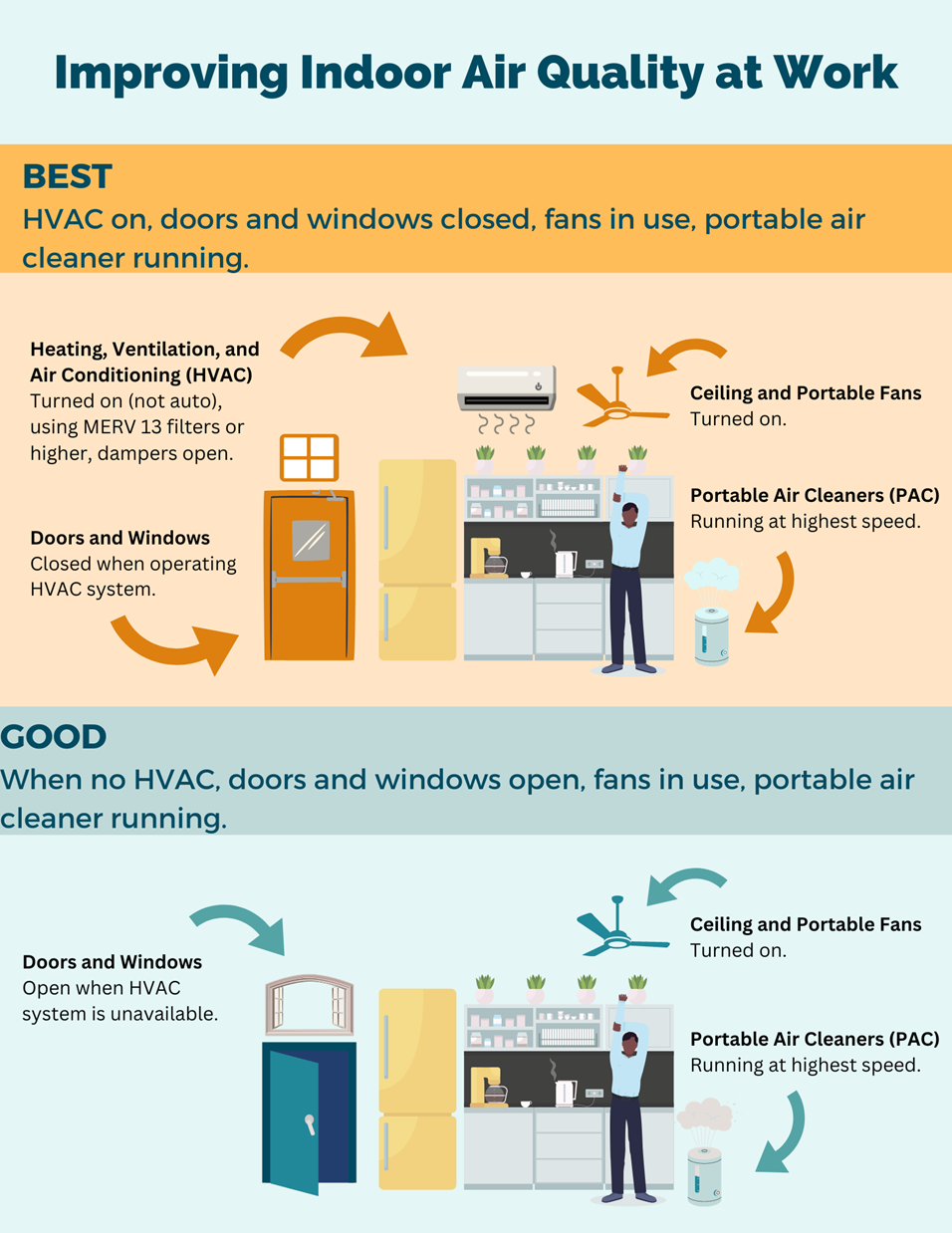Yes, opening windows can improve indoor air quality. It allows fresh air to replace stale air, reducing pollutants inside.
Our homes often trap pollutants like dust, mold, and chemicals. Poor indoor air can affect our health, causing allergies or respiratory problems. By opening windows, we let in fresh air and let out harmful particles. This simple action can make a big difference in improving the air we breathe indoors.
Fresh air can dilute indoor pollutants and help maintain a healthier living environment. So, let’s explore how opening windows can enhance indoor air quality and why it matters for our well-being.

Credit: www.homecraftinc.com
Benefits Of Fresh Air
Opening windows to let in fresh air can greatly improve indoor air quality. Fresh air offers numerous benefits for your overall well-being. Below, we explore some of the key advantages.
Improved Mood
Breathing fresh air can uplift your mood. When you open windows, you allow natural air to circulate. This can reduce feelings of stress and anxiety. Fresh air is rich in oxygen, which helps in releasing serotonin. Serotonin is a neurotransmitter that promotes feelings of happiness. A well-ventilated room can therefore lead to a more positive environment.
Enhanced Cognitive Function
Fresh air can also boost your cognitive function. Studies show that increased oxygen levels improve brain function. This means better focus and enhanced memory. Opening windows allows more oxygen into your living space. This can be especially beneficial for those working from home or studying. Improved air quality helps in maintaining concentration and mental clarity.

Credit: www.cdph.ca.gov
Reducing Indoor Pollutants
Opening windows can significantly reduce indoor pollutants, creating a healthier living space. It allows fresh air to circulate, pushing out stale air that may contain various pollutants.
Dust And Allergens
Dust and allergens are common indoor pollutants. These can come from various sources such as:
- Furniture
- Carpets
- Pets
Opening windows helps to flush out dust particles and allergens. Fresh air entering the room can reduce the concentration of these irritants. This is especially beneficial for those with allergies or asthma.
Chemical Vapors
Many household items release chemical vapors. These items include:
- Cleaning products
- Paints
- Air fresheners
These vapors can accumulate over time, affecting indoor air quality. Opening windows allows these vapors to disperse, reducing their concentration. This makes the air inside your home cleaner and safer to breathe.
| Source of Pollutants | Examples |
|---|---|
| Dust and Allergens | Furniture, Carpets, Pets |
| Chemical Vapors | Cleaning Products, Paints, Air Fresheners |
Regularly opening windows helps maintain good indoor air quality. It is a simple yet effective way to reduce indoor pollutants.
Energy Efficiency Considerations
Opening windows can greatly affect indoor air quality. Yet, energy efficiency considerations are crucial. Balancing air quality with heating and cooling costs can be challenging. This section explores these aspects.
Heating And Cooling Impact
When windows are open, indoor temperature can change rapidly. In winter, cold air enters the home. This can lead to increased heating costs. In summer, the situation reverses. Warm air from outside can raise indoor temperatures. Air conditioners must work harder to cool the space. This increases energy consumption.
Balancing Fresh Air And Energy Use
Fresh air is essential for a healthy home. Yet, open windows can let conditioned air escape. This creates a need for more heating or cooling. To balance this, consider opening windows at strategic times. Early morning or late evening can be ideal. Outdoor temperatures are usually milder then. This can reduce the impact on heating or cooling systems.
Another strategy is to use fans. They can help circulate fresh air without significant energy loss. Ceiling fans, for example, can help distribute air evenly. This allows for a comfortable indoor climate.
Health Benefits
Opening windows can do wonders for your indoor air quality. Fresh air flows in, pushing out stale air. This simple act can have significant health benefits. Let’s explore how it can improve your respiratory health and reduce illness transmission.
Respiratory Health
Fresh air helps your lungs. It reduces indoor air pollutants. Dust, mold, and pet dander levels drop. These allergens can irritate your respiratory system. Opening windows lets in clean air. This can help your lungs function better.
People with asthma and allergies benefit the most. They breathe easier with fresher air. Even without these conditions, clean air helps. It keeps your airways clear and healthy. Fresh air supports overall lung health.
Reduced Illness Transmission
Opening windows can lower the spread of illnesses. Germs thrive in closed, stuffy spaces. Fresh air dilutes these germs. This reduces the chances of getting sick.
Ventilation is key during flu season. Open windows let fresh air circulate. This can help remove airborne pathogens. It’s a simple yet effective way to stay healthier.
Schools and offices benefit too. Better air quality means fewer sick days. Everyone enjoys a healthier environment.
Optimal Times To Open Windows
Opening windows can significantly improve indoor air quality. But, it’s essential to know the optimal times to do so. Factors like season and time of day play a crucial role in maximizing the benefits.
Seasonal Considerations
Different seasons bring different air quality conditions. Understanding these can help you decide when to open your windows for the best results.
| Season | Optimal Times |
|---|---|
| Spring | Early morning and late evening |
| Summer | Early morning and late evening |
| Fall | Mid-morning and mid-afternoon |
| Winter | Midday |
Daily Timing
Within each day, certain times are better for opening windows. Timing can help you avoid outdoor pollutants and maximize fresh air intake.
- Early Morning: Air is usually cleaner and cooler. Open your windows to let in fresh air.
- Late Evening: Similar to the morning, the air quality tends to be better. It’s also cooler, which can help ventilate your home.
- Midday: This is ideal during colder seasons like winter. The air outside is warmer, reducing the chill inside your home.
By following these guidelines, you can improve your indoor air quality efficiently. Remember, the key lies in timing and understanding seasonal variations.

Credit: publichealthinsider.com
Complementary Ventilation Methods
Opening windows can greatly improve indoor air quality. It is crucial to consider additional methods to ensure optimal ventilation. Complementary ventilation methods include using fans, exhaust systems, and air purifiers.
Fans And Exhaust Systems
Fans help circulate air within your home. They can be ceiling fans, floor fans, or wall-mounted fans. Circulating air prevents it from becoming stagnant.
Exhaust systems are another effective method. They remove stale or polluted air from specific areas. Common areas include kitchens and bathrooms. Exhaust fans are usually installed in these locations.
Benefits of Fans and Exhaust Systems:
- Enhance air circulation
- Remove odors and pollutants
- Reduce humidity levels
Having a combination of fans and exhaust systems can significantly improve indoor air quality.
Air Purifiers
Air purifiers can be a valuable addition to your home. They filter out pollutants, allergens, and toxins. This helps to provide cleaner and fresher air.
Types of Air Purifiers:
| Type | Function |
|---|---|
| HEPA filters | Remove small particles like dust and pollen |
| Activated carbon filters | Eliminate odors and chemical vapors |
| UV-C light purifiers | Kill bacteria and viruses |
Using an air purifier can complement natural ventilation. This ensures your indoor environment remains healthy and free from harmful substances.
Challenges And Solutions
Opening windows can help improve indoor air quality. But, it isn’t without challenges. Let’s explore the hurdles and solutions for better air quality through open windows.
Weather Conditions
Weather plays a big role in the decision to open windows. During cold months, open windows may not be practical. The cold air can make heating systems work harder. This increases energy costs. On the other hand, during hot months, open windows can let in warm air. This can make cooling systems work harder and also increase energy costs.
One solution is to use window screens. They allow fresh air in while keeping out insects and dust. Another option is to open windows during early morning or late evening. The temperature is often cooler during these times.
Noise And Security Concerns
Noise can be another issue. Busy streets and construction sites can bring in a lot of noise. This can be distracting and stressful. Security is another concern. Open windows can make it easier for intruders to enter.
One solution is to use soundproof window inserts. They help block out noise without compromising on fresh air. For security, consider installing window locks. They allow windows to open only a few inches, keeping your home safe.
Practical Tips
Opening windows can significantly improve indoor air quality. Here are some practical tips to maximize the benefits.
Window Placement
Not all windows are equal. The placement of your windows matters. To get the best air flow, open windows on opposite sides of your home. This creates a cross-ventilation effect. Fresh air enters through one side, stale air exits through the other.
If your home has only windows on one side, consider using fans. Place a fan near the open window to push air out. Use another fan inside to pull fresh air in. This method helps to circulate air more effectively.
| Window Placement | Air Flow |
|---|---|
| Opposite Sides | Best |
| One Side | Use Fans |
Duration For Airing Out
How long should you keep windows open? A short duration won’t be effective. Aim to air out your space for at least 15 to 30 minutes. This duration ensures enough air exchange.
For better results, do this twice a day. Morning and evening times are ideal. Cooler temperatures during these times can help in better air circulation.
In colder months, you can still benefit. Open windows for a shorter time, about 5 to 10 minutes. This reduces heat loss while still allowing fresh air inside.
- 15 to 30 minutes twice a day
- Morning and evening for best results
- 5 to 10 minutes in colder months
Frequently Asked Questions
Can Opening Windows Improve Air Quality?
Yes, opening windows can improve indoor air quality. It allows fresh air to circulate. This helps remove indoor pollutants and reduce humidity.
How Often Should I Open Windows For Ventilation?
You should open windows for at least 15 minutes daily. This helps to refresh indoor air and remove contaminants.
Does Opening Windows Help Reduce Indoor Pollutants?
Yes, opening windows helps reduce indoor pollutants. Fresh air dilutes harmful substances, improving overall air quality.
Is It Beneficial To Open Windows In Winter?
Yes, it’s beneficial to open windows briefly in winter. This helps to ventilate and reduce indoor air pollution, even in cold weather.
Conclusion
Opening windows can greatly improve indoor air quality. Fresh air helps reduce pollutants. It also decreases humidity, which prevents mold. Natural ventilation is cost-effective and simple. Your home will feel fresher. It’s an easy habit to adopt. So, open your windows regularly.
Enjoy cleaner, healthier air. Your lungs will thank you.
Rakib Sarwar is a Registered Pharmacist and a reputed health and wellness blogger. He has a great interest in Air purifiers.
